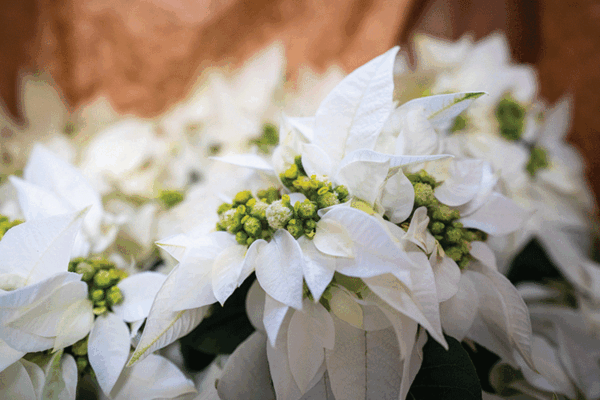 From Texas A&M AgriLife Horticulturists
From Texas A&M AgriLife Horticulturists
Poinsettias and their classic red and white holiday color will soon be abundant in homes, grocery stores and nurseries. If you want your poinsettia plants to last throughout the holiday season, here are some pointers to help keep your plants happy.
These gorgeous holiday plants, native to Mexico, are the No. 2 dollar-valued potted plant in the U.S. behind orchids. McKinley said poinsettias were introduced domestically by Joel Poinsett in the 1800s and have since been bred to maximize the colors and varieties of the plant.
How to pick your poinsettias
When it comes to picking a good poinsettia plant, the color of the petal you choose doesn’t impact how long your plant lasts. You should be looking in the center of the plant to find the healthiest plant.
“The little center of the poinsettia plant, the true blossom, shouldn’t be fuzzy,” McKinley said. “They should be tight and yellow.”
Making sure your plants last
If you want to keep your plant alive during the holiday season, you should keep a light hand when watering your poinsettias.
McKinley said one of the most common errors with the plant is overwatering. Poinsettias don’t like when the roots are sitting in water, which can happen if they are left in the waterproof container that they are often sold in.
 The best way to water is to take your plant out of the container so that the water can drain before you put it back in its container, he said.
The best way to water is to take your plant out of the container so that the water can drain before you put it back in its container, he said.
“If you water your poinsettia and leave it in that container, the water will drain down and the plant will be sitting in water, causing root rot,” McKinley said.
How to make your poinsettias thrive
Where you choose to display your poinsettias can impact your plants. McKinley said it is best to keep your plants in bright but indirect sunlight. It is also important to keep your plants away from heaters or air conditioners.
Mahal said poinsettias should be kept away from areas that fluctuate in temperature.
“The ideal room temperature for plants is between 65-70 degrees,” she said. “And avoid exposing them to temperatures below 50 degrees.”
Poinsettias and pets
Contrary to popular belief, poinsettias are not toxic to our furry friends. Mahal said that poinsettias are not a major point of concern with pets.
“The sticky white sap can irritate the mouth and cause mild gastrointestinal symptoms,” Mahal said. “But they are not a threat to animals.”
Keeping your plants year-round
Consumers should also know that they don’t have to throw out their plants as soon as holiday décor is taken down. With proper care, poinsettias can last years and provide annual blooms each holiday season.
McKinley said to prune the plant halfway up the main stem soon after the holidays and replant them in a larger size pot. Put them in bright light indoors and a shady area outdoors once the temperatures are consistently above 60 degrees. Keep the plant watered.
“You might have to pinch the tips to keep it bushy,” McKinley says, “But in July, you’ll have to stop pinching or you won’t get any flowers.”
The plant should be protected from artificial light after the fall equinox to promote poinsettia blooms. So, bring them inside and place them in total darkness between sundown and sunrise.
“In late October and the first part of November, your plant will start to show color,” McKinley said. “And by Christmas it should be in full bloom.”













